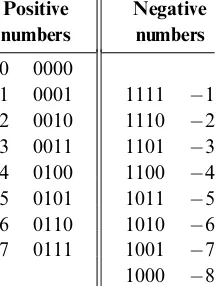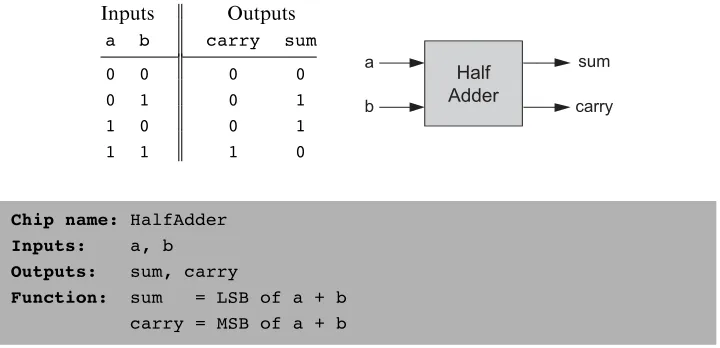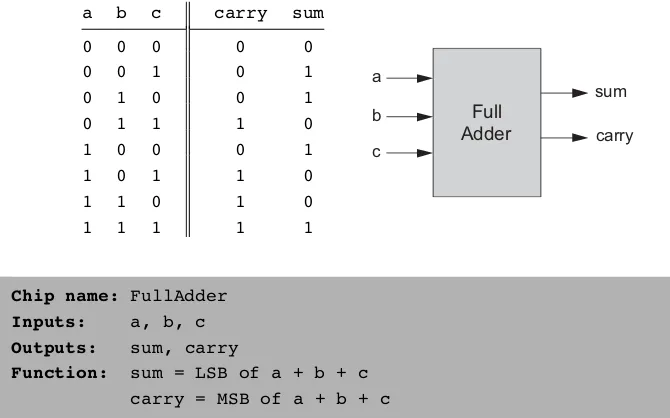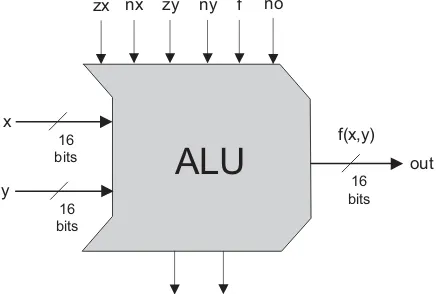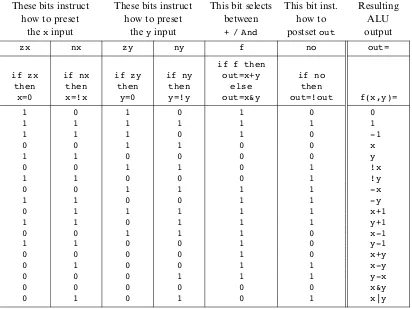Counting is the religion of this generation, its hope and salvation. —Gertrude Stein (1874–1946)
In this chapter we build gate logic designs that represent numbers and perform arithmetic operations on them. Our starting point is the set of logic gates built in chapter 1, and our ending point is a fully functional Arithmetic Logical Unit. The ALU is the centerpiece chip that executes all the arithmetic and logical operations performed by the computer. Hence, building the ALU functionality is an important step toward understanding how the Central Processing Unit (CPU) and the overall computer work.
As usual, we approach this task gradually. The first section gives a brief Back-ground on how binary codes and Boolean arithmetic can be used, respectively, to represent and add signed numbers. The Specification section describes a succession of adder chips, designed to add two bits, three bits, and pairs ofn-bit binary numbers. This sets the stage for the ALU specification, which is based on a sophisticated yet simple logic design. The Implementation and Project sections provide tips and guidelines on how to build the adder chips and the ALU on a personal computer, using the hardware simulator supplied with the book.
2.1
Background
Binary Numbers Unlike the decimal system, which is founded on base 10, the bi-nary system is founded on base 2. When we are given a certain bibi-nary pattern, say ‘‘10011,’’ and we are told that this pattern is supposed to represent an integer num-ber, the decimal value of this number is computed by convention as follows:
ð10011Þtwo¼124þ023þ022þ121þ120¼19 ð1Þ
The reader can verify that in the case ofð10011Þtwo, rule (2) reduces to calculation (1). The result of calculation (1) happens to be 19. Thus, when we press the keyboard keys labeled ‘1’, ‘9’ andENTERwhile running, say, a spreadsheet program, what ends up in some register in the computer’s memory is the binary code 10011. More pre-cisely, if the computer happens to be a 32-bit machine, what gets stored in the regis-ter is the bit patregis-tern 00000000000000000000000000010011.
Binary Addition A pair of binary numbers can be added digit by digit from right to left, according to the same elementary school method used in decimal addition. First, we add the two right-most digits, also called theleast significant bits(LSB) of the two binary numbers. Next, we add the resulting carry bit (which is either 0 or 1) to the sum of the next pair of bits up the significance ladder. We continue the process until the twomost significant bits(MSB) are added. If the last bit-wise addition generates a carry of 1, we can report overflow; otherwise, the addition completes successfully:
0 0 0 1 (carry) 1 1 1 1
1 0 0 1 x 1 0 1 1
þ 0 1 0 1 y þ 0 1 1 1
0 1 1 1 0 xþy 1 0 0 1 0
no overflow overflow
Signed Binary Numbers A binary system withn digits can generate a set of 2n dif-ferent bit patterns. If we have to represent signed numbers in binary code, a natural solution is to split this space into two equal subsets. One subset of codes is assigned to represent positive numbers, and the other negative numbers. Ideally, the coding scheme should be chosen in such a way that the introduction of signed numbers would complicate the hardware implementation as little as possible.
This challenge has led to the development of several coding schemes for repre-senting signed numbers in binary code. The method used today by almost all com-puters is called the 2’s complement method, also known as radix complement. In a binary system withndigits, the 2’s complement of the numberxis defined as follows:
x¼ 2nx if x00
0 otherwise
For example, in a 5-bit binary system, the 2’s complement representation of 2 or ‘‘minusð00010Þtwo’’ is 25 ð00010Þ
two¼ ð32Þten ð2Þten¼ ð30Þten¼ ð11110Þtwo. To check the calculation, the reader can verify thatð00010Þtwoþ ð11110Þtwo¼ ð00000Þtwo. Note that in the latter computation, the sum is actuallyð100000Þtwo, but since we are dealing with a 5-bit binary system, the left-most sixth bit is simply ignored. As a rule, when the 2’s complement method is applied ton-bit numbers,xþ ðxÞalways sums up to 2n(i.e., 1 followed byn0’s)—a property that gives the method its name. Figure 2.1 illustrates a 4-bit binary system with the 2’s complement method.
An inspection of figure 2.1 suggests that ann-bit binary system with 2’s comple-ment representation has the following properties:
Positive
m The system can code a total of 2n signed numbers, of which the maximal and
minimal numbers are 2n11 and2n1, respectively.
m The codes of all positive numbers begin with a 0.
m The codes of all negative numbers begin with a 1.
m To obtain the code of xfrom the code ofx, leave all the trailing (least
signifi-cant) 0’s and the first least significant 1 intact, then flip all the remaining bits (convert 0’s to 1’s and vice versa). An equivalent shortcut, which is easier to implement in hardware, is to flip all the bits ofxand add 1 to the result.
A particularly attractive feature of this representation is that addition of any two signed numbers in 2’s complement is exactly the same as addition of positive num-bers. Consider, for example, the addition operation ð2Þ þ ð3Þ. Using 2’s comple-ment (in a 4-bit representation), we have to add, in binary, ð1110Þtwoþ ð1101Þtwo. Without paying any attention to which numbers (positive or negative) these codes represent, bit-wise addition will yield 1011 (after throwing away the overflow bit). As figure 2.1 shows, this indeed is the 2’s complement representation of5.
In short, we see that the 2’s complement method facilitates the addition of any two signed numbers without requiring special hardware beyond that needed for sim-ple bit-wise addition. What about subtraction? Recall that in the 2’s comsim-plement method, the arithmetic negation of a signed number x, that is, computing x, is achieved by negating all the bits ofxand adding 1 to the result. Thus subtraction can be easily handled byxy¼xþ ðyÞ. Once again, hardware complexity is kept to a minimum.
The material implications of these theoretical results are significant. Basically, they imply that a single chip, calledArithmetic Logical Unit, can be used to encapsulate all the basic arithmetic and logical operators performed in hardware. We now turn to specify one such ALU, beginning with the specification of anadderchip.
2.2
Specification
2.2.1 Adders
We present a hierarchy of three adders, leading to a multi-bit adder chip:
m Half-adder: designed to add two bits
m Full-adder: designed to add three bits
We also present a special-purpose adder, called incrementer, designed to add 1 to a given number.
Half-Adder The first step on our way to adding binary numbers is to be able to add two bits. Let us call the least significant bit of the additionsum, and the most signif-icant bit carry. Figure 2.2 presents a chip, called half-adder, designed to carry out this operation.
Full-Adder Now that we know how to add two bits, figure 2.3 presents afull-adder chip, designed to add three bits. Like the half-adder case, the full-adder chip pro-duces two outputs: the least significant bit of the addition, and the carry bit.
Adder Memory and register chips represent integer numbers by n-bit patterns, n being 16, 32, 64, and so forth—depending on the computer platform. The chip whose job is to add such numbers is called a multi-bit adder, or simplyadder. Figure 2.4 presents a 16-bit adder, noting that the same logic and specifications scale up as is to anyn-bit adder.
Incrementer It is convenient to have a special-purpose chip dedicated to adding the constant 1 to a given number. Here is the specification of a 16-bit incrementer:
Inputs Outputs
a b carry sum
0 0 0 0 Half
Adder
a sum
b carry
0 1 0 1
1 0 0 1
1 1 1 0
Chip name: HalfAdder Inputs: a, b Outputs: sum, carry
Function: sum = LSB of a + b carry = MSB of a + b
a b c carry sum
Figure 2.3 Full-adder, designed to add 3 bits.
... 1 0 1 1 a
Overflow is neither detected nor handled.
Chip name: Inc16 Inputs: in[16] Outputs: out[16] Function: out=in+1
Comment: Integer 2’s complement addition.
Overflow is neither detected nor handled.
2.2.2 The Arithmetic Logic Unit (ALU)
The specifications of the adder chips presented so far were generic, meaning that they hold for any computer. In contrast, this section describes an ALU that will later be-come the centerpiece of a specific computer platform calledHack. At the same time, the principles underlying the design of our ALU are rather general. Further, our ALU architecture achieves a great deal of functionality using a minimal set of inter-nal parts. In that respect, it provides a good example of an efficient and elegant logic design.
The Hack ALU computes a fixed set of functionsout¼fiðx;yÞwherexand yare the chip’s two 16-bit inputs, out is the chip’s 16-bit output, and fi is an arithmetic or logical function selected from a fixed repertoire of eighteen possible functions. We instruct the ALU which function to compute by setting six input bits, called control bits, to selected binary values. The exact input-output specification is given in figure 2.5, using pseudo-code.
Note that each one of the six control bits instructs the ALU to carry out a certain elementary operation. Taken together, the combined effects of these operations cause the ALU to compute a variety of useful functions. Since the overall operation is driven by six control bits, the ALU can potentially compute 26¼64 different
func-tions. Eighteen of these functions are documented in figure 2.6.
We see that programming our ALU to compute a certain function fðx;yÞis done by setting the six control bits to the code of the desired function. From this point on, the internal ALU logic specified in figure 2.5 should cause the ALU to output the value fðx;yÞspecified in figure 2.6. Of course, this does not happen miraculously, it’s the result of careful design.
For example, let us consider the twelfth row of figure 2.6, where the ALU is instructed to compute the function x-1. The zx and nx bits are 0, so the x input is neither zeroed nor negated. The zy and ny bits are 1, so the y input is first zeroed, and then negated bit-wise. Bit-wise negation of zero, ð000. . .00Þtwo, gives
zx no
Inputs: x[16], y[16], // Two 16-bit data inputs
zx, // Zero the x input
nx, // Negate the x input
zy, // Zero the y input
ny, // Negate the y input
f, // Function code: 1 for Add, 0 for And
no // Negate the out output
Outputs: out[16], // 16-bit output
zr, // True iff out=0
ng // True iff out<0
Function: if zx then x = 0 // 16-bit zero constant
if nx then x = !x // Bit-wise negation
if zy then y = 0 // 16-bit zero constant
if ny then y = !y // Bit-wise negation
if f then out = x + y // Integer 2's complement addition
else out = x & y // Bit-wise And
if no then out = !out // Bit-wise negation
if out=0 then zr = 1 else zr = 0 // 16-bit eq. comparison
if out<0 then ng = 1 else ng = 0 // 16-bit neg. comparison
Comment: Overflow is neither detected nor handled.
and1. Since thef-bit is 1, the selected operation isarithmetic addition, causing the ALU to calculate x+(-1). Finally, since the no bit is 0, the output is not negated but rather left as is. To conclude, the ALU ends up computing x-1, which was our goal.
Does the ALU logic described in figure 2.6 compute every one of the other seven-teen functions listed in the figure’s right column? To verify that this is indeed the case, the reader can pick up some other rows in the table and prove their respec-tive ALU operation. We note that some of these computations, beginning with the These bits instruct
function fðx;yÞ ¼1, are not trivial. We also note that there are some other useful functions computed by the ALU but not listed in the figure.
It may be instructive to describe the thought process that led to the design of this particular ALU. First, we made a list of all the primitive operations that we wanted our computer to be able to perform (right column in figure 2.6). Next, we used backward reasoning to figure out how x, y, and outcan be manipulated in binary fashion in order to carry out the desired operations. These processing requirements, along with our objective to keep the ALU logic as simple as possible, have led to the design decision to use six control bits, each associated with a straightforward binary operation. The resulting ALU is simple and elegant. And in the hardware business, simplicity and elegance imply inexpensive and powerful computer systems.
2.3
Implementation
Our implementation guidelines are intentionally partial, since we want you to dis-cover the actual chip architectures yourself. As usual, each chip can be implemented in more than one way; the simpler the implementation, the better.
Half-Adder An inspection of figure 2.2 reveals that the functions sumða;bÞ and carryða;bÞ happen to be identical to the standard Xorða;bÞand Andða;bÞBoolean functions. Thus, the implementation of this adder is straightforward, using pre-viously built gates.
Full-Adder A full adder chip can be implemented from two half adder chips and one additional simple gate. A direct implementation is also possible, without using half-adder chips.
Adder The addition of two signed numbers represented by the 2’s complement method as twon-bit buses can be done bit-wise, from right to left, in nsteps. In step 0, the least significant pair of bits is added, and the carry bit is fed into the addition of the next significant pair of bits. The process continues until in stepn1 the most significant pair of bits is added. Note that each step involves the addition of three bits. Hence, ann-bit adder can be implemented by creating an array ofnfull-adder chips and propagating the carry bits up the significance ladder.
ALU Note that our ALU was carefully planned to effect all the desired ALU operationslogically, using simple Boolean operations. Therefore, thephysical imple-mentation of the ALU is reduced to implementing these simple Boolean operations, following their pseudo-code specifications. Your first step will likely be to create a logic circuit that manipulates a 16-bit input according to thenxandzxcontrol bits (i.e., the circuit should conditionally zero and negate the 16-bit input). This logic can be used to manipulate thex andyinputs, as well as theout output. Chips for bit-wise And-ing and addition have already been built in this and in the previous chap-ter. Thus, what remains is to build logic that chooses between them according to the fcontrol bit. Finally, you will need to build logic that integrates all the other chips into the overall ALU. (When we say ‘‘build logic,’’ we mean ‘‘write HDL code’’).
2.4
Perspective
The construction of the multi-bit adder presented in this chapter was standard, although no attention was paid to efficiency. In fact, our suggested adder implemen-tation is rather inefficient, due to the long delays incurred while the carry bit prop-agates from the least significant bit pair to the most significant bit pair. This problem can be alleviated using logic circuits that effect so-called carry look-ahead techniques. Since addition is one of the most prevalent operations in any given hardware plat-form, any such low-level improvement can result in dramatic and global perfor-mance gains throughout the computer.
In any given computer, the overall functionality of the hardware/software plat-form is delivered jointly by the ALU and the operating system that runs on top of it. Thus, when designing a new computer system, the question of how much function-ality the ALU should deliver is essentially a cost/performance issue. The general rule is that hardware implementations of arithmetic and logical operations are usually more costly, but achieve better performance. The design trade-off that we have chosen in this book is to specify an ALU hardware with a limited functionality and then implement as many operations as possible in software. For example, our ALU features neither multiplication nor division nor floating point arithmetic. We will implement some of these operations (as well as more mathematical functions) at the operating system level, described in chapter 12.
2.5
Project
Objective Implement all the chips presented in this chapter. The only building blocks that you can use are the chips that you will gradually build and the chips described in the previous chapter.
Tip When your HDL programs invoke chips that you may have built in the previ-ous project, we recommend that you use the built-in versions of these chips instead. This will ensure correctness and speed up the operation of the hardware simulator. There is a simple way to accomplish this convention: Make sure that your project directory includes only the.hdlfiles that belong to the present project.
